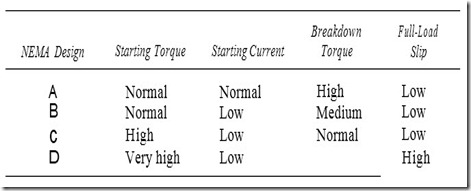MOTOR TYPE
The type of motor will determine the electrical characteristics of the design. NEMA has designated the following designs for polyphase motors:
An A motor is a three-phase, squirrel cage motor designed to with stand full voltage starting with locked rotor current higher than the values for a B motor and having a slip at rated load of less than 5%.
A B motor is a three-phase, squirrel cage motor designed to with stand full voltage starting and developing locked rotor and breakdown torques adequate for general application and having a slip at rating load of less than 5%.
A C motor is a three-phase, squirrel cage motor designed to with stand full voltage starting, developing locked rotor torque for special high-torque applications, and having a slip at rated load of less than 5%.
Design D is also a three-phase, squirrel cage motor designed to with stand full voltage starting, developing 275% locked rotor torque, and having a slip at rated load of 5% or more.
SYNCHRONOUS MOTORS
A synchronous polyphase motor has a stator constructed in the same way as the stator of a conventional induction motor. The iron core has slots into which coils are wound which are also arranged and connected in the same way as the stator coils of the induction motor. These are in turn grouped to form a three-phase connection, and the three free leads are connected to a three-phase source. Frames are equipped with air ducts which aid the cooling of the windings, and the coil guards protect the winding from damage.
The rotor of a synchronous motor carries poles which project toward the armature and are called salient poles. The coils are wound on lami nated pole bodies and connected to slip rings on the shaft. A squirrel cage winding for starting the motor is embedded in the pole faces.
The pole coils are energized by direct current, which is usually supplied by a small de generator called the exciter. This exciter may be mounted directly on the shaft to generate de voltage which is applied through brushes to slip rings. On low-speed synchronous motors, the ex citer is normally belted or of a separate high-speed motor-driven type.
The dimensions and construction of synchronous motors vary great ly, depending on the rating of the motors. However, synchronous motors for industrial power applications are rarely built for less than 25 hp or so. In fact, most are 100 hp or more. All are polyphase motors when built in this size. Vertical and horizontal shafts with various bearing arrange ments and various enclosures cause wide variations in the appearance of the synchronous motor.
Synchronous motors are used in electrical systems where there is need for improvement in power factor or where a low power factor is not desirable. This type of motor is especially adapted to heavy loads that operate for long periods of time without stopping, such as for air compressors, pumps, ship propulsion, and the like.
The construction of the synchronous motor is well adapted for high voltages, as it permits good insulation. Synchronous motors are fre quently used on 2300 V or more. Their efficient slow-running speed is another advantage.
